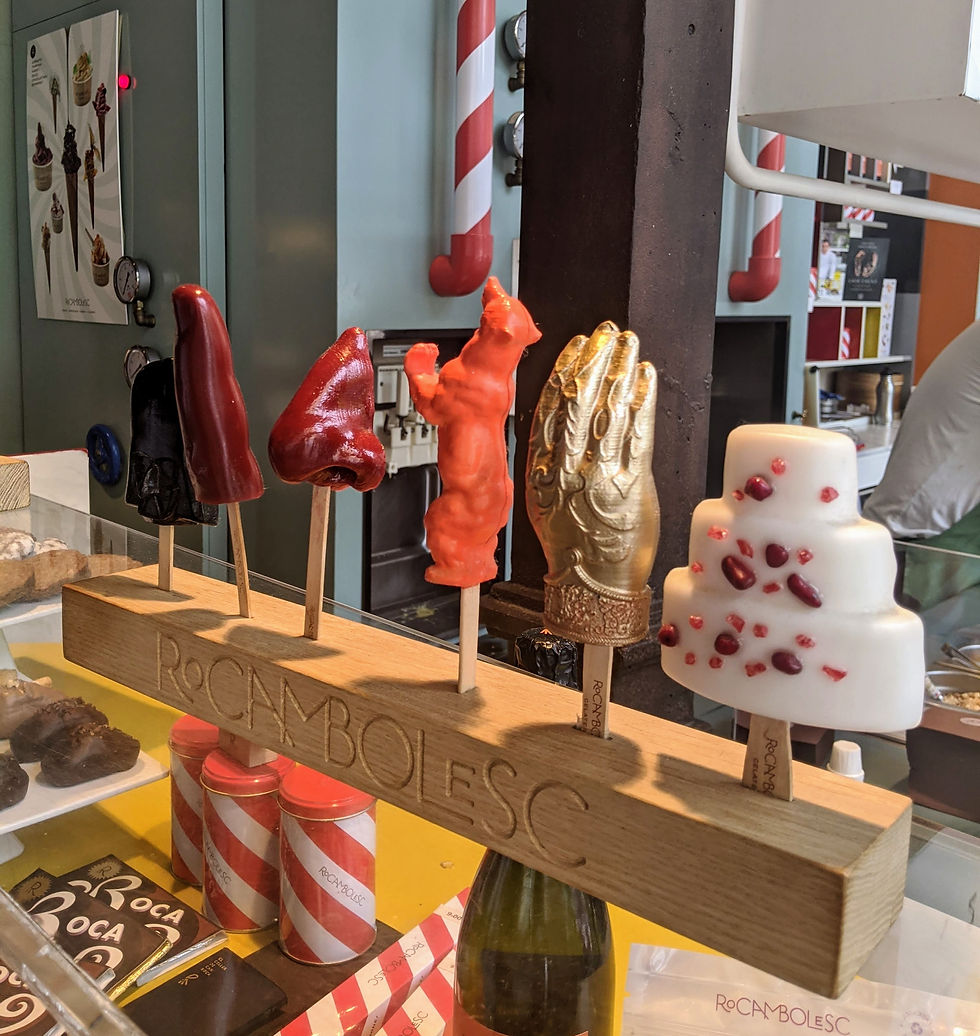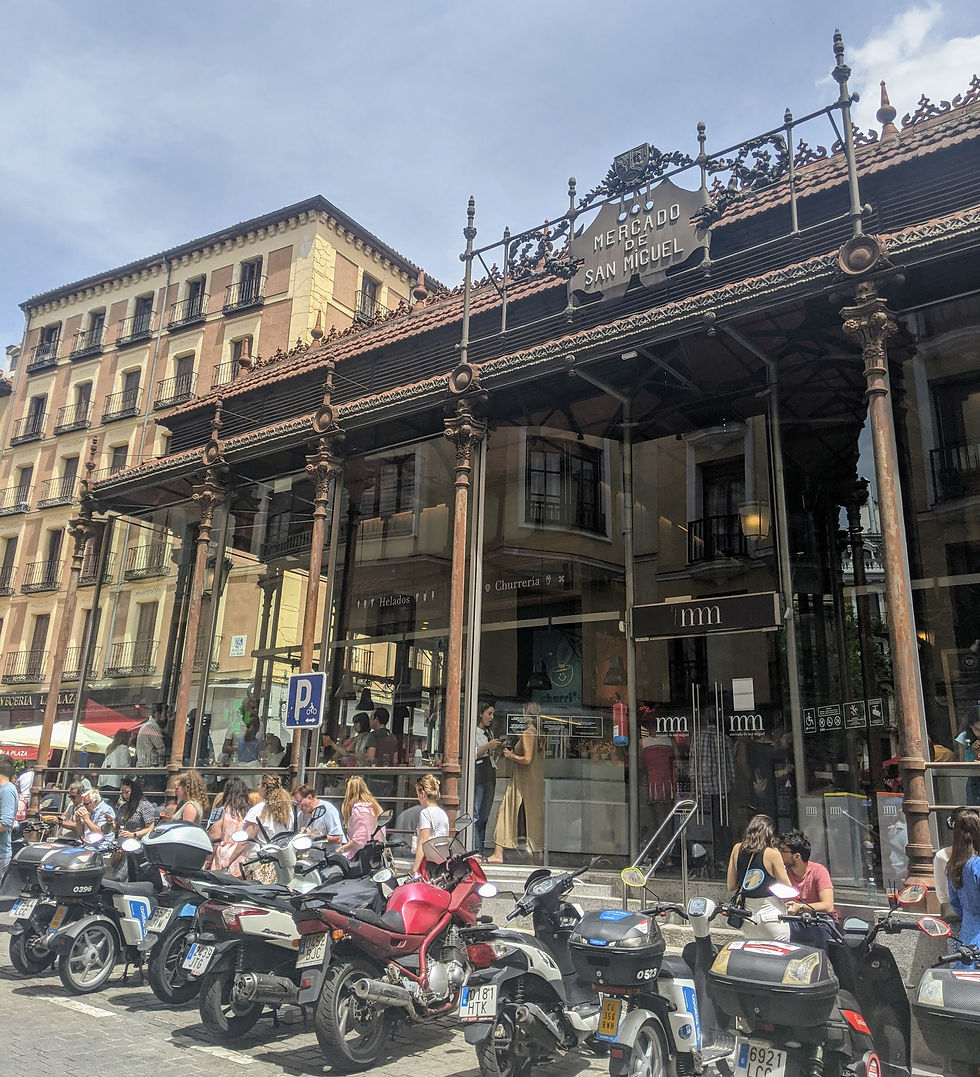Come For The Tapas, Stay For The History: Mercado de San Miguel
- sienaduncan8
- May 18, 2022
- 4 min read
By Siena Duncan
In the heart of Madrid, elegant wrought iron frames one of the oldest markets in the city. Through the glass walls, you can see crowds flocking up and down the aisles. It is full to the brim with locals and tourists alike.
This is Mercado de San Miguel, where traditional style architecture meets gourmet food and Michelin-level chefs. It boasts 30 different stalls, including a few bars and coffee spots. Mostly, though, the businesses are tapas focused.

Generally, within the market each tapas is about €4. Some places do run more expensive, depending on the type of food.

It’s just a two minute walk from Placa Mayor, Madrid’s largest plaza. If you’re in the neighborhood around lunchtime, it’s worth considering a visit.
CUISINE
Most of the booths specialize in a specific kind of food: salmon, for example, at Ahumados Dominguez, or potato omelets at Picolisto. Naturally, mozzarella is the star of the show at the Mozzarella Bar.

A recommendation from tour guides keeps it teeming with non-locals. However, the variety is what draws many of the natives who make the market a regular stop.
Oysters and caviar sit next to lollipops and chocolate croissants. A stall serving bao, a traditional Chinese sandwich, is directly across from a place serving traditional Spanish paella.

If you’re looking for a place that can please everyone, Mercado de San Miguel would be a smart choice.
It would also be a quality choice. A couple of Michelin star winners have made the market home. Joan Roca (three Michelin stars) serves homemade ice cream from Rocambolesc.
The stall’s description dramatically calls it a “monument to desserts,” though it's not inaccurate-- you can buy popsicles, chocolates and bonbons as well as ice cream to sate your sweet tooth.

A few stalls over is the simply named Paella, run by Rodrigo de la Calle (one Michelin star).
Surrounded by clever and creative spins on dishes, Paella sticks to the classics, embracing tradition. Black rice and shellfish are staples at this particular stall. The original Spanish paella recipe can be found here, no bells and whistles.
BOISTEROUS CROWDS
Security guard David Wilson likes the paella stall the best. He also likes the bao, and the salmon.
He’s been working at Mercado de San Miguel for three months, and on his lunch breaks he likes to try things he’s never had before in the market. He’s working his way through each stall.
“It’s great getting to sample all these things,” he said. “It’s a good way to experience how colorful Spanish culture is. You can go beyond all the bread and cheese and meat.”
David is from England. He’s been living in Madrid for a few years.
Various staff members wear all black outfits like him, with the double M logo sewn onto the chest. There’s a team of janitors that pick up stray plates and glasses and keep the area clean.
David’s job is to stand outside and keep an eye out for any suspicious characters. He said that due to the crowded nature of the market, it can be very easy for pickpockets to slip by unnoticed.
“You should hold your things close,” he said.
Still, he said that during his three months there, he hasn’t had to apprehend anyone running off with someone’s things.
The market welcomes almost 10 million visitors a year. Generally, it’s very busy around both American and Spanish lunchtime hours, so expect large crowds from 11 a.m to 4 p.m.
However, if you go later than that, some of the stalls close for siesta, or the late afternoon break that most Spanish workers take.
The large number of people can be a turn-off for some tourists. Katherine Hayes was celebrating her 21st birthday in Madrid and decided to pay a visit to the market, but it was too packed for her liking.
She tried the bao, and was hoping to get some ice cream at Rocambolesc later on.
“It feels like you have to fight to get your order in at some places,” she said. “It’s super loud in there, too. But I’m glad I was able to get my food.”
A MARKET THAT NEEDED SAVING
The market began as a local place to find fresh produce and other groceries back in 1916, sprawling out into the surrounding streets. Women in light flowy dresses and men in suit jackets would walk down cobblestone to find their favorite booths.
In 1999, it was remodeled to have its updated glass walls, while still keeping the iron frame to preserve its history.

However, it was quickly losing business, since it could not compete with the arrival of massive supermarkets in Spain. Locals no longer relied on it for their produce. There were talks of demolishing it and replacing it with housing.
In a last ditch attempt to save the market, a group that was a melting pot of interests (food critics, architecture scholars, history professors) formed the company El Gastrónome de San Miguel.
It bought out the market. Taking inspiration from Barcelona’s La Boqueria, the company planned to replace basic food stalls with mini restaurants and bars.
It hoped that this would draw a more modern, trendy audience in, and revive the cultural staple it once had been to Madrid.
Drawing the attention of popular chefs in the area, the idea gained enough attention to fill its 30 booths with the restaurants that now serve customers there today. It reopened in 2009 as Madrid’s first gourmet food market.

In a way, the bustling crowds bring you back to what it might have been like over a century ago: families and friends wandering the aisles looking for something good to eat, servers calling out orders over the noise, young Spanish people chatting back and forth over a mid-afternoon beer.
For most of the week, the area is open right up until midnight. That leaves lots of room to stop by during the day and the night. So even if you’re not looking for a bite to eat, it’s still worth paying a visit to feel the liveliness of Spanish culture, old and new.









Comments